
Pandemonium! is a 1996 platform video game developed by Toys for Bob and published by Crystal Dynamics for the PlayStation, Sega Saturn, Microsoft Windows, N-Gage, mobile and iOS. Pandemonium! features Fargus, a joker, and Nikki, a sorceress, who unwittingly casts a spell that destroys the town. The goal of the game is to reach the Wishing Engine, where they can wish the town back to normal. For each level, the player can choose which character to be. Each has a special move – Fargus can deliver a special spinning attack, and Nikki can double jump. The game consists of a great variety of unique gameplay objects, such as watermelons, clouds, spider webs and logs. A sequel, Pandemonium 2, was released in 1997 for PlayStation and Microsoft Windows.

Castlevania: Legacy of Darkness is an action-adventure platforming video game, that was developed and published by Konami for the Nintendo 64. It was released in 1999 and is a prequel and expanded version of Castlevania, also released on the Nintendo 64 earlier the same year; it contains a remake of the original game with improved graphics, added villains, and alternate versions of some levels.

War Gods is a fighting video game originally released to arcades by Midway Games in 1996. Ports for the Nintendo 64, PlayStation and Windows were released in 1997. In the game, players control one of ten fighters who have been given great power by a mysterious ore that crashed-landed on Earth from outer space. The object of the game is to defeat all the other fighters to become the most powerful warrior on the planet.
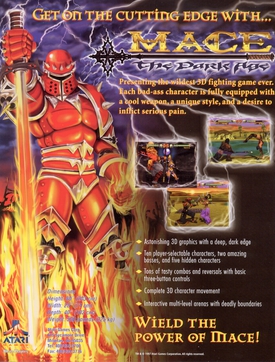
Mace: The Dark Age is a fighting video game released by Atari Games for arcade machines in 1997 and later ported by Midway Games to the Nintendo 64. Like many fighting games of the time, its style is marked by extreme violence, with characters graphically slaying defeated opponents. Utilizing 3dfx Voodoo chips for the hardware, the game received attention for its cutting-edge graphics and turned Atari a profit in the arcades. Critical response to the gameplay was much less enthusiastic.

Contra: Hard Corps, released as Contra: The Hard Corps in Japan and Probotector in Europe and Australia, is a run and gun video game released by Konami for the Sega Genesis in 1994, making it the first game in the Contra series released for a Sega platform.

Bug! is a platform game developed by Realtime Associates and published by Sega for the Sega Saturn. It was first released in North America, in 1995, weeks after the Saturn's launch there; in Europe on September 15, 1995; and, in Japan, on December 8 the same year. It was also ported to Windows 3.1x and Windows 95 in 1996 by Beam Software. The game is one of the earliest examples of 3D platforming, as well as one of the first platform games released on the Saturn. Character movement is restricted to a track, unlike many in the genre that allow for unrestricted movement in all directions.

Contra is a video game series produced by Konami composed primarily of run and gun-style shooting games. The series debuted in February 1987 with the Japanese coin-operated arcade game of the same name, which was has since spawned several sequels produced for various platforms.

C: The Contra Adventure is a 3D action game produced by Konami and developed by Appaloosa Interactive that was released for the PlayStation in 1998. It was the second of two Contra games Konami of America co-produced with Appaloosa, following Contra: Legacy of War in 1996. C: The Contra Adventure was never released in Japan, Europe, or Australia.
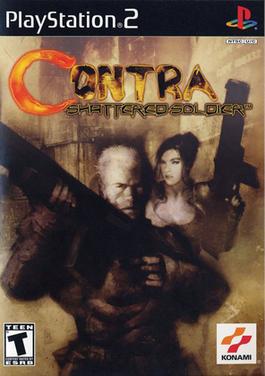
Contra: Shattered Soldier, originally released in Japan as Shin Contra, is a video game that is part of the Contra series by Konami. It was developed by Team Kijirushi, a group of staff members within Konami Computer Entertainment Tokyo. The game marks a return to the two-dimensional gameplay style employed by the series prior to Contra: Legacy of War. A sequel to Contra: Hard Corps, the game was released for the PlayStation 2 in 2002 and for the PlayStation Network in both 2012 for Japan and 2013 for North America.

Neo Contra is the tenth video game in the Contra series published by Konami. It was developed by Team Neo Kijirushi, a group of staff members within Konami Computer Entertainment Tokyo, and released for the PlayStation 2 in 2004. The game is a direct follow-up to Contra: Shattered Soldier, but returns to the multidirectional shooting format and departs from the traditional scrolling shooter formula used in previous games. It was the first game in the series to receive an M (Mature) rating from the ESRB and was the only installment to receive this rating until the release of Rogue Corps in 2019.

Iron Man / X-O Manowar in Heavy Metal is a video game published by Acclaim Entertainment and developed by Realtime Associates for the PlayStation, Sega Saturn, Game Boy, Game Gear, and MS-DOS in 1996. It is a one or two-player side-scrolling action game in which the player battles villains from Marvel Comics' Iron Man and Valiant Comics' X-O Manowar comic book series. It was met with negative reviews which criticized it for dull gameplay and outdated graphics.
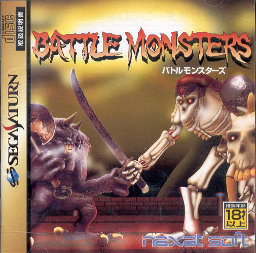
Battle Monsters (バトルモンスターズ) is a versus fighting game developed by Scarab for the Sega Saturn. It was originally published by Naxat Soft in Japan and later published in North America and Europe by Acclaim Entertainment. Similar to Atari's Pit-Fighter, the game makes heavy use of digitized human actors as the characters, plus some blood influenced by Midway's Mortal Kombat series. The game features 12 playable fighters, and plays out on multi-tiered stages.

Madden NFL 97 is a football video game released in 1996. It was the first multiplatform Madden game released for the 32-bit consoles, being released on both the PlayStation and Sega Saturn. 16-bit versions were also made for the established Super NES and Genesis platforms, as well as a portable version for the Game Boy.

Alien Trilogy is a first-person shooter video game developed by Probe Entertainment and published by Acclaim Entertainment in 1996 for the PlayStation, Sega Saturn, and MS-DOS platforms. The game is based on the first three movies in the Alien film series. One of the first games developed by Probe following their acquisition by Acclaim, it debuted Acclaim's much-hyped motion capture technology. The game was well-received by critics, who praised its recreation of the films' atmosphere and its gameplay depth compared to other first-person shooters, and was a commercial success.

Contra 4 is a 2D action game published by Konami Digital Entertainment in the United States and developed by WayForward Technologies. It is the eleventh overall installment of the Contra series, and was released in North America on November 13, 2007 for Nintendo DS. A mobile port was released six days later on November 19, 2007. A rerelease, called Contra 4: Redux, was released for Android in 2011.
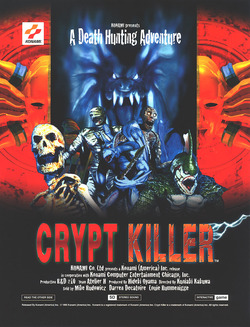
Crypt Killer is a 1995 arcade video game produced by Konami. It was also released in 1997 for the Sega Saturn and Sony PlayStation home consoles, and in Japan for Microsoft Windows. The Saturn version makes use of the Saturn's various light guns, while the PlayStation version is compatible with the Naki Lunar Gun and the Konami Justifier. The game's scenery and characters are all 3D polygon models, while most of the enemies and their projectiles are 2D sprites.
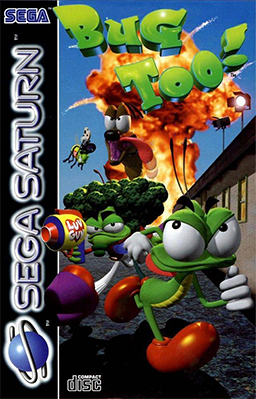
Bug Too! is a side-scrolling platforming video game developed by both Realtime Associates and SegaSoft. It is the sequel to Bug!, which was developed and published by Realtime Associates and Sega. It was first released for the Sega Saturn on December 6, 1996 in North America. It was later ported to Windows devices on December 10 of the same year in both North America and PAL regions. Finally, it was released in PAL regions for the Sega Saturn on April 24, 1997. Players are given the option of choosing from Bug, Maggot Dog, or Super Fly, a trio of action movie stars, who must proceed through a series of mostly 2D levels across multiple zones, with a boss level at the end of each zone.
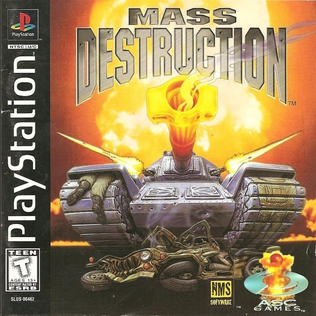
Mass Destruction is a 1997 third-person action game developed by NMS Software and published by ASC Games and BMG Interactive. Released for MS-DOS, the Sega Saturn, and the PlayStation, the game puts players in control of a tank, and tasks them with destroying enemy forces. It has often been likened to Return Fire.

Contra III: The Alien Wars is a 1992 run and gun video game developed and published by Konami for the Super Nintendo Entertainment System (SNES). It is the third home console entry in the Contra series after Contra (1988) and Super C (1990) for the Nintendo Entertainment System (NES). In PAL regions, it was retitled Super Probotector: Alien Rebels and the player characters were replaced with robots. The player is tasked with fighting off an alien invasion of Earth across six stages. Four stages feature side-scrolling action traditional to the series while two are presented from an overhead perspective. It is the first Contra title to have been directed by Nobuya Nakazato who later directed other games in the series. He designed Contra III to feature more comical elements, a more cinematic soundtrack, and tighter stage design than its predecessors.

Soviet Strike is a helicopter-based shooter game developed and published by Electronic Arts for the PlayStation in 1996 and the Sega Saturn in 1997. The game is a sequel to the Strike games which began on the Sega Genesis with Desert Strike: Return to the Gulf. Soviet Strike is the series' first installment for a 32-bit console and was first conceived as 32-bit Strike. Early on, it was intended for the 3DO console, before development changed to the PlayStation.




















